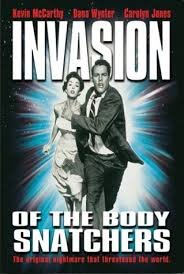Who knew that the cautionary plot of this slim novel would endure for so many years? This post first ran in 2016.
During my many decades—or is that centuries?—living on this planet I have encountered a number of people who’ve shared the same childhood nightmare. In it, they awaken one morning to discover that their mother is not their mother, or their favorite uncle is no longer their uncle…or sister, or father, or whomever. More than likely these folks, as kids, saw the same movie—the 1956 classic sci-fi thriller, Invasion of the Body Snatchers. (See my post, “They’re Here Already!”) Or perhaps the excellent 1978 remake of the same name. (See my post, “Is ‘Outstanding Remake’ An Oxymoron?” Also, check out my post, “What Is Capgras Delusion?”)
 Both these films, plus two subsequent ones in 1993 and 2007, have their origins in a novel titled, The Body Snatchers, by Jack Finney. First published in 1954 in serial form by Collier’s magazine, the story came out in book form a year later, and a revised edition appeared in 1978, likely to coincide with the release of the second movie. Though panned by critics of the day, the story had enough chops to spawn adaptations as much as half a century later.
Both these films, plus two subsequent ones in 1993 and 2007, have their origins in a novel titled, The Body Snatchers, by Jack Finney. First published in 1954 in serial form by Collier’s magazine, the story came out in book form a year later, and a revised edition appeared in 1978, likely to coincide with the release of the second movie. Though panned by critics of the day, the story had enough chops to spawn adaptations as much as half a century later.
DID ANY OF THE FILMS ECHO THE NOVEL?
Fans of the 1956 version, which starred Kevin McCarthy and Dana Wynter, would find the novel quite familiar, the others, not so much. The film’s setting is different—the fictional Santa Mira, near L.A., replaces the real Mill Valley, north of San Francisco, though both represent Small Town U.S.A. Otherwise, we have town doctor Miles Bennell approached by old flame Becky Driscoll, whose cousin, Wilma Lentz, has a delusion that her Uncle Ira is not her Uncle Ira, and a boy who says his mother is not his mother, and so on. Miles’s friends, mystery writer Jack Belicec and his wife, find an “unfinished” body on their pool table, and ultimately they join Miles and Becky in trying to learn what is happening in Mill Valley.
There are minor differences throughout, as one would expect. The more significant ones occur in 1) the explanation by “pod person” Dr. Kaufman as to who/what these aliens actually are, and 2) the ending. In fact, counting the novel and the four films, there are five different endings. I’ll talk about that shortly.
 HOW DID EARTH GET SO LUCKY?
HOW DID EARTH GET SO LUCKY?
In the novel, Kaufman and another pod person, Budlong, explain how these alien organisms—“seeds,” to simplify things—left a dying planet to drift through space for millions of years, occasionally taking root upon planets that had life. For adaptability and survival they took on all of the characteristics of their hosts, duplicating them down to the last molecule while they slept, then turning their bodies into “gray fluff,” or dust. They would drain each planet of its resources before moving on. Now, it was Earth’s turn, its destiny for everyone to be transformed into emotionless pod people, to simply—survive.
BUT—that’s a big but—because these aliens cannot duplicate reproduction, their time on our world is limited. In about five years they will have drained this planet of everything before moving on, leaving another dead world behind. Holy crap, Miles and Becky think.
The 1956 film did not go this far. It sounded like the pod people would go on living their ordinary lives indefinitely, with no love, no hate, no wars—no joy. That was enough for the screen Miles and Becky to try and stay awake forever.
DUST TO DUST
 Yes, and speaking of “dust to dust,” I always wondered why, in the 1956 movie, we never saw what happened to the original body after the alien took over. The book does mention that, once drained of everything, the body becomes a pile of gray fluff, or dust, and can be disposed of easily. Given the nature of Hollywood censorship back in the day, they might’ve thought such a scene might prove too gross.
Yes, and speaking of “dust to dust,” I always wondered why, in the 1956 movie, we never saw what happened to the original body after the alien took over. The book does mention that, once drained of everything, the body becomes a pile of gray fluff, or dust, and can be disposed of easily. Given the nature of Hollywood censorship back in the day, they might’ve thought such a scene might prove too gross.
But that sure as heck didn’t stop the filmmakers in the 1978 version of Invasion of the Body Snatchers, or the third remake in 1993, simply titled, Body Snatchers. In each, the newly formed pod person is shown the next day standing at the curb with a small trash bag, waiting for a garbage truck that inevitably shows up. And both films ultimately show the bodies disintegrating after the transformation—seriously shocking in 1978, even more gross but commonplace by 1993.
We’ll check out all of the endings in next week’s Throwback Thursday post.
